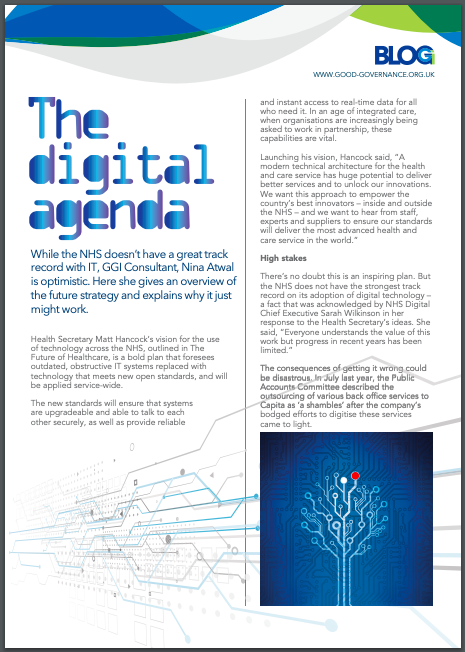The Digital Agenda for the NHS
16 July 2019

While the NHS doesn’t have a great track record with IT, GGI Consultant, Nina Atwal is optimistic. Here she gives an overview of the proposed digital strategy and explains why it just might work.
Health Secretary Matt Hancock’s vision for the use of technology across the NHS, outlined in The Future of Healthcare, is a bold plan that foresees outdated, obstructive IT systems replaced with technology that meets new open standards, and will be applied service-wide.
The new standards will ensure that systems are upgradeable and able to talk to each other securely, as well as provide reliable and instant access to real-time data for all who need it. In an age of integrated care, when organisations are increasingly being asked to work in partnership, these capabilities are vital.
Launching his vision, Hancock said, “A modern technical architecture for the health and care service has huge potential to deliver better services and to unlock our innovations. We want this approach to empower the country’s best innovators – inside and outside the NHS – and we want to hear from staff, experts and suppliers to ensure our standards will deliver the most advanced health and care service in the world.”
High stakes
There’s no doubt this is an inspiring plan. But the NHS does not have the strongest track record on its adoption of digital technology – a fact that was acknowledged by NHS Digital Chief Executive Sarah Wilkinson in her response to the Health Secretary’s ideas. She said, “Everyone understands the value of this work but progress in recent years has been limited.”
The consequences of getting it wrong could be disastrous. In July last year, the Public Accounts Committee described the outsourcing of various back office services to Capita as ‘a shambles’ after the company’s bodged efforts to digitise these services came to light. Capita’s mistakes led to a host of issues including a failure to send cervical screening letters to tens of thousands of women and the incorrect archiving of 160,000 patient records.

Inaction is not an option
But despite the potentially appalling consequences of getting it wrong the NHS has no alternative but to get better at the way it uses integrated digital technology. It’s an essential element in tackling the multiple demographic and economic challenges facing the service.
Last year, NHS England’s National Director for Operations, Matthew Swindells, had a stark message for those who thought extra funding alone would solve the problems facing the service. Commenting on the current model, he said, “We can’t afford it. We couldn’t staff it even if we could afford it, and anyway, it’s wrong. If we don’t digitise our health service, we are condemning people to die.”
There are significant hurdles to clear before the Health Secretary’s digital vision can be realised. Hancock himself acknowledged that the starting point for digital technology across the NHS is low, describing day-to-day IT systems as “Clunky, clunky, clunky.” In addition, the more health management relies on digital tools such as mobile apps, the more aware board members must be of the security and data privacy challenges that come with them.
The key is to wholeheartedly embrace digital technology – but to do so responsibly and cautiously. In 2019, it is unacceptable for board members to claim ignorance about technology’s great potential and also of its potential pitfalls. Now is the time to be asking searching questions as boards seek to deliver the kind of high-quality, efficient and secure digital services that could just be the saviour of the NHS.

